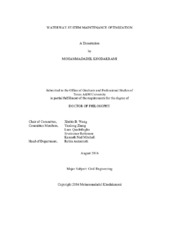| dc.description.abstract | Coastal lines, harbors/ports, and inland waterways constitute the marine transportation system, a major component of the United States freight system, carrying a vast majority of foreign imports and exports and a significant amount of domestic freight. This system needs regular maintenance. US Army Corps of Engineers (USACE) is in charge of the waterway system maintenance. However, the limited maintenance budget needs to accommodate a large number of maintenance requests for dredging and dam repair, etc. The requests often exceed the budget available by much. A decision facing the USACE management is what projects to fund and how to select them. This research aims at providing the necessary models and tools to facilitate maintenance decisions at the USACE. The objective is to maximize the overall system improvement under annual limited budget. The underlying problem can be modeled as a knapsack problem with an additional constraint that increases the problem complexity. The additional constraints describe the benefit interdependency of different maintenance projects due to the waterways network effect.
This research tackles the maintenance problem at different levels. First, an integer selection model is developed to find the optimal set of dredging projects (waterway sediment removal operation) and some heuristics are developed to provide near-optimal solutions in computationally guaranteed polynomial time. Next, a model is developed to allow partial dredging. Partial dredging means partially conducting the requested dredging operation. The model is able to determine the percentage of the dredging depth to fund instead of a zero-one dredging decision for each project.
Further, a stochastic problem is considered regarding to the probabilistic shoaling process. To solve the probabilistic problem, two methods are designed: an analytical model that takes account of probability in terms of expected values, and a stochastic optimization approach was developed based on Monte-Carlo simulation.
Finally, the problem is modeled in a multi-modal context where the maintenance decisions are made simultaneously on dredging and lock/dam improvement. In this multimodal model, the effect of landside modes’ capacity is considered comprehensively. All the developed methods are tested with real examples from US marine network and their performance is approved by comparison to real situation. | en |


